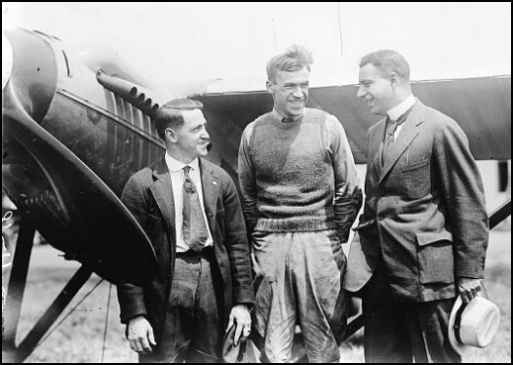
 |
Library of Congress Collection, 1-13-11 |
 |
|
|
S. E. J. Cox Says His "Texas Wildcat" Flew 223 Miles an Hour Special to The New York Times. "We had intended keeping this record a strict, secret until the time of the race," Mr. Cox declared, "but we have just learned that foreign interests have learned of the achievement and may take steps to bar us from the race, due to the great advantage our planes have over any other yet built. We have without question the fastest machines in the world, and we are going to get our entries into the event and bring the Gordon Bennett trophy back to America." Roland Rohlfs and Clarence Coombs record holding aviators, will pilot the Cox planes in the cup race. They sailed with four planes and Mr. and Mrs. Cox and their son, Seymour, who became prominent as a youthful flyer when he flew from his home in Houston, Te3xas to the Raymond Riordan School at Highland, N. Y., last Fall , will sail for France Sept. 7. Published August 30, 1920 Coopyright © The New York Times" |
Coombs accused of larceny: http://query.nytimes.com/mem/archive-free/pdf?res=F20614FF345D1A7A93C5AB178BD95F468285F9 Was responsible for starting idea of Floyd Bennett Memorial Airport, Warren, NY "On September 12, 1940, Col. Clarence B Coombs approached the Warren County Board of Supervisors for the purpose of conferring with State, Local and Federal officials on the feasibility and desirability of such an airport. It was determined that an airport would be a good investment due to the area being in a direct line between New York City and Montreal." http://www.warrencountydpw.com/Airport_07/History.htm Test flew the first Orenco D biplane fighter: The pilot of the first flight test, Clarence B. Coombs, gave it a positive evaluation: "This aircraft performs better than the Sopwith Camel and Snipe, the Thomas-Morse, the Nieuport and Morane Parasol, the Spad and S.V.A."[1] http://en.wikipedia.org/wiki/Orenco_D In January 1919 the prototype was tested by Lieutenant Clarence B. Coombs at McCook Field in Dayton, Ohio, and showed such an excellent performance that 50 aircraft were ordered. http://1000aircraftphotos.com/APS/3404.htm Library of Congress Collection, 1-13-11 |
|
Clarence B. Coombs came in second in the 5 lap, 155.35 mile race on November 5, 1921. He was flying a Curtiss-Cox Cactus Kitten and reached an average speed of 170.3 mph. The race was won by Bert Acosta flying a USN Curtiss R-1 at a speed of 176.7 mph. you can find more details by clicking on the Pulitzer Trophy Races You can also find an entry on the Curtiss-Cox Cactus Kitten |
|
AUBURN, N. Y. SEPTEMBER 8, 1940 WPA BARES PLAN FOR 150 STATE LANDING FIELDS Fifty Such Links in Airport Chain Expected to Be Constructed By July 1 As Defense Step Development of the first link in the military airport chain, a 118-acre site in Saratoga County to accommodate the nation's biggest bombers, is scheduled to be started within a fortnight. Approximately 50 more fields aree expected to be constructed by next July 1, the WPA said. Necessary War Department approval of the project awaits assignment of rights of way from counties where the proposed fields are located. WPA officials pointed out, however, the project is in accord with recommendations of the army's air defense. The army defense command, recently created to co-ordinate activities of anti-aircraft, pursuit ships and a civilian air warning service in combating aerial attack, advocated development of such fields in New York during a simulated bombing attack in northern New York's August war maneuvers. Col. Clarence B. Coombs of the Army Air Corps is consultant to upstate WPA Administrator Lester W. Herzog on the airfield construction. He explained the scattered sites are necessary as a defense against concentrated bombing by an air invader and as a means of permitting swift interception of anemy aircraft. The landing sites to accommodate both the largest and intermediate size bombing planes and atack ships, would have paved strips 3,000 to 4,000 feet long and from 100 to 150 feet wide. They would be adjacent to arterial highways, thus permitting easy transportation of fuel and other supplies. Coombs maintained the fields could easily be hidden from the air in time of war by camouflage. When not in combat use, however, the sites would "encourage widespread development of civil aviation," he added. "From 2,500 to 3,500 war planes could be hidden in these landing fields in event of war," Coombs explains. Cost of the air defense chain, Herzog said, would be borne mainly by the WPA, which would supply the men and materials to construct the fields. Counties would supply the land and grading equipment. In an effort to construct the fields as speedily as possible, Herzog declared the state was invited to sponsor the projects as part of Governor Lehman's defense program. 'The program would be speeded greatly with the help of state facilities," Herzog said. "Nearly 100 of these fields could be ready for use by next July 1 through state sponsorship." |


|